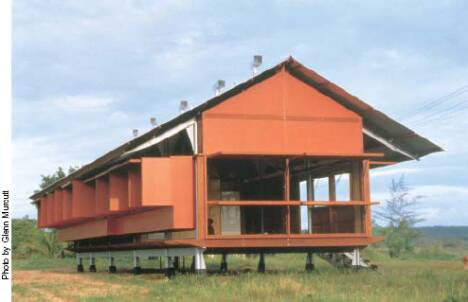 |
|
|

MARIKA ALDERTON
HOUSE, NORTHERN TERRITORY, 1991-1994
15 April 2002
Glenn Murcutt, 66 year old sole practitioner from
Sydney, and visiting professor of architecture at Washington University,
yesterday received the the Pritzker Prize, which is basically the
biggest gong in architecture.
The Pritzker Prize has built a name for itself since 1979 when Philip
Johnson took the inaugural prize. Funded by the family behind the
Hyatt Hotel chain to fill a gap in the Nobel role call, the mission
of the Pritzker is to, "honour annually a living architect
whose built work demonstrates a combination of those qualities of
talent, vision and commitment, which has produced consistent and
significant contributions to humanity and the built environment
through the art of architecture.
This year's award contrasts markedly with the gong-getters of recent
times. Herzog and de Meuron (2001) and Rem Koolhaas (2000) were
european architects working on large projects with large offices.
The jury, which included Ada Louise Huxtable, Carlos Jimenez and
Lord Rothschild, determined that Murcutt is an "innovative
architectural technician who is capable of turning his sensitivity
to the environment and to locality into forthright, totally honest,
non-showy works of art."
The international cult for Murcutt will be stoked further by quotes
like this from Ada Louise Huxtable: "Glenn Murcutt has become
a living legend, an architect totally focused on shelter and the
environment, with skills drawn from nature and the most sophisticated
design traditions of the modern movement." This cult can be
witnessed in action by doing a search for australian architecture
at designcommunity.com.
Most of the results are posts about Glenn. And apparently he doesn't
do PR!
It seems that Murcutt is a popular study choice in many overseas
(not to mention australian) schools. His work inspires students
looking for something a little more personal, contextually responsive,
and environmentally aware than what most of today's architecture
has to offer. That Murcutt now spends time lecturing around the
world can only enhance his status, and indirectly that of Australian
architecture.
Murcutt's work has also bridged that gap to the general public.
His name is known like none other in Australian architecture (excepting
a certain Dane). The 1985 best-selling publication 'Leaves of Iron'
and more recent discussions in print and on radio have endeared
him to a wide audience. The reason for this is partly his personable
style, but I'd say it mostly stems from people's appreciation of
his work trying to connect with the Australian landscape, where
few dare go.
PRITZKER
PRIZE 2002
|
|
|
|
|
His
architecture is crisp, marked and impregnated by the unique landscape
and by the light that defines the fabulous, far away and gigantic
mass of land that is his home, Australia. Yet his work does not
fall into the easy sentimentalism of a chauvinistic revisitation
of the vernacular. Rather, a considered, serious look would trace
his buildings' lineage to modernism, to modern architecture, and
particularly to its Scandinavian roots planted by Asplund and Lewerentz
, and nurtured by Alvar Aalto.
JUROR
JORGE SILVETTI
I
have had to fight for my architecture. I have fought for it right
from the outset because councils have clearly found the work a threat.
For many designs I put to council, we either had to resort to a
court for the outcome or better, negotiate a satisfactory result,
always trying to avoid a compromise. I have had the greatest trouble
with planning, building and health department staff, many of whom
have backgrounds unrelated to architecture, but offer very conservative
judgments in taste and aesthetics.
GLENN AT THE
COUNCIL
|
|